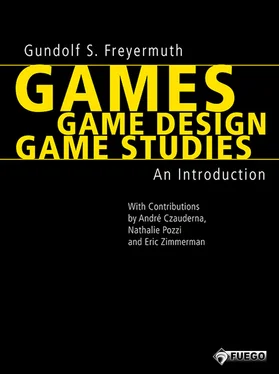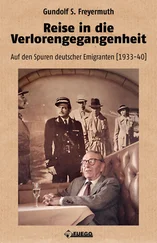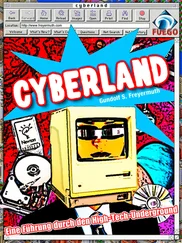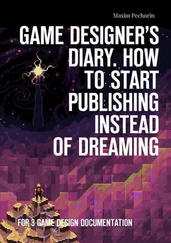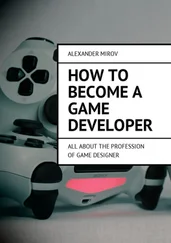One year later, at a time when approximately 9,000 computers were running worldwide, about 1,000 of which were mid-sized computers used by individuals, 10MIT students set the standard for ‘rebel computing’ when they programmed the game SPACEWAR! With their deliberate ‘waste’ of expensive processing power, these students replaced work-ethic with play-ethic. 11Thus, the economic efficiency principal of collective organization was displaced by the luxurious pleasure principle of the individual.
ARTIFICIAL INTELLIGENCE
SPACEWAR! was, however, by no means the first digital game. Already in the 1940s the thought had circulated in leading-edge research, originating from Alan Turing’s and Claude Elwood Shannon’s deliberations that computer games in general, but specifically digital versions of CHESS, could eventually demonstrate an attempt at artificial intelligence through competition with human players. Shannon wrote in 1950:
“Although perhaps of no practical importance, the question [of computer Chess] is of theoretical interest, and it is hoped that a satisfactory solution of this problem will act as a wedge in attacking other problems of a similar nature and of greater significance.” 12
However, with its high potential of possible moves, CHESS proved to be too complicated at first for algorithmic representation, which requires decontextualizing abstraction. The matchstick game NIM was easier to algorithmatize; this process was made possible through a specially constructed computer, Nimrod. 13Its programmer, John Bennett, like Shannon, connected his digital game with greater hopes:
“It may appear that, in trying to make machines play games, we are wasting our time. This is not true as the theory of games is extremely complex and a machine that can play a complex game can also be programmed to carry out very complex practical problems.“ 14
Then in 1952, A.S. Douglas programmed NOUGHTS AND CROSSES, a digital version of TIC TAC TOE , as part of his doctoral thesis. In the same year IBM presented the first digital game of CHESS. By 1955 the program was so advanced that it learned from its own mistakes. In the 1960s chess programs started to win against amateurs. However, it would take another two decades until finally, in 1997, IBM’s Big Blue beat reigning world champion Garry Kasparow.
FLIGHT SIMULATION
The second area of research that led to digital games concerned military and civilian flight simulators, which were developed at great cost for training purposes. Analog simulators with limited capabilities existed since the First World War. Their digitalization began in the last months of World War II, when the Servomechanisms Laboratory at MIT received the contract to develop a “universal flight trainer,” a real-time flight simulator that, unlike previous ones, could simulate more than just a single, predetermined airplane model. 15 Project Whirlwind was planned as a two-year endeavor. However, this first attempt at the construction of a—first analog, then digitally conceived—computer designated for real-time control of simulations ultimately failed. Only in the 1960s did regular mainframe and microcomputers become powerful enough for such an undertaking.
The National Aeronautics and Space Administration (NASA) was the driving force behind this development. Flight training through simulation promised to provide long-term savings in exchange for large short-term investments. However, in the case of the planned moon mission, the only possibility for training was through realistic simulation. 16Already in 1967, General Electric delivered the first electronic real-time 3D simulator to Johnson Space Center in Houston, Texas. David Evans, together with computer graphics pioneer Ivan Sutherland, constructed another digital prototype in 1968. Their combination of optimized hard- and innovative software calculated new images from digital recordings of real scenes, which could change their perspectives to match the actions of the pilot or astronaut. With the virtual perspectival modeling of 3D images, the basic defining innovation of digital games had been realized.
The first commercial flight simulator, which generated markedly abstract virtual images in real-time, became available in 1971. During this time, after Intel had introduced the microprocessor in 1970, the social and technical construction of the personal computer began in the West Coast hacker-scene in the US. Two types of programs proved to be the most successful because they satisfied needs that were suppressed in the regulated-usage of the expensive mainframes found at universities, in management, and at large companies: the need for personal productivity and creativity as well as for entertainment. Among commercial software products, computer games earned the highest number of sales at the end of the 1970s. They were played both on hobbyist PCs and on consoles equipped with microprocessors. Thus digital games (and among them notably flight simulators) served as a ‘gateway drug’ for a new generation of computer enthusiasts. 17
The first flight simulators for personal computers like the Apple II and the Tandy TRS-80 were released at the end of the 1970s. In 1981 one of the most popular Apple programs was FLIGHT SIMULATION by a company called SubLogic, which was later acquired by Microsoft. In 2001, MS FLIGHT SIMULATOR secured a place in the Guinness Book of Records for earning 21 million sales. 18During this time other successful digital simulations were created—most notably Will Wright’s SIM CITY (1989) and Peter Molyneux’s POPULOUS (1989), both of which generated complex situations and behavior patterns from relatively simple rules and thereby offered experiences of open play.
VIRTUALIZATION OF ANALOG GAMES
Playable simulations, both old and new, function through the virtualization and algorithmic automation of real-world processes and procedures. The digitalization of analog games occurred in the same way. In the beginning it affected board and sports games equally. Unlike the virtualizations programmed in the area of AI-research and under the auspices of academic insight, the motivation behind this third group of early digital games was focused on improving playability and the fun factor. Trailblazers of this movement were war games of the classical Prussian tradition and other types of strategy games. While the analog versions of these games demanded time-consuming calculations, sometimes requiring the aid of a sliding rule, desk or hand calculator, the digital versions drastically accelerated gameplay through the use of computers; in principle, they enabled real time play.
In the fifties and sixties such digitalization was largely restricted to military training due to the high cost of digital technology. With the rise of the affordable personal computer, however, digital adaptations of analog games became one of the most successful areas of game production. A deciding factor of their success can be attributed to the performance enhancement enabled by virtualization and algorithmization. This boost motivated, for example, Chris Crawford already in 1977 to realize TANKTICS, a digital war game programmed on his university’s IBM mainframe: “I was playing board war games and I was acutely aware of the absence of the fog of war, which I consider to be crucial to simulation of warfare […] I considered that computers could solve the problem. I don’t think people fully appreciated just how big a leap this was.” 19The first commercial war games for PCs came out in the eighties, mostly as adaptations of board war games. 20
Similarly around 1960 academic research began to strive for the algorithmization of sports games. Already in 1958 TENNIS FOR TWO, played on the screen of an oscilloscope, was created through the use of an analog computer at the Brookhaven National Laboratory. Over a decade later, when the first digital game console became available for purchase, it included a table tennis game. Atari-founder Nolan Bushnell played a prototype of this console and then had a similar game programmed. With PONG in 1972, Bushnell brought the first digital game to the arcades and, three years later with the Atari console, into the living room as well. And thus began a long tradition of digital sports games as home entertainment. Today there is hardly a sport in existence, which does not have its virtual equivalent. In particular, licensed league games such as FIFA or MADDEN NFL comprise one of the most popular and lucrative game genres.
Читать дальше
